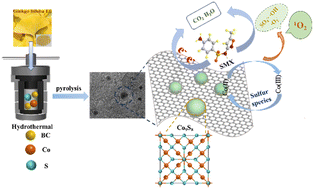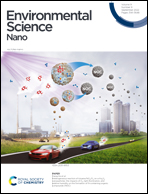A porous graphitic biochar wrapped Co9S8 core–shell composite enables pH-universal activation of peroxymonosulfate for highly efficient and rapid antibiotics degradation†
Abstract
Metal sulfides have been found to be effective in removing organic pollutants from water in environmental catalysis. In this study, a porous graphitic biochar wrapped Co9S8 core–shell composite (Co9S8@N–O–BC) was designed for efficient activation of peroxymonosulfate (PMS) and degradation of sulfamethoxazole in an aqueous environment. Based on complementary characterizations and reactive oxygen species (ROS) quenching experiments, we proposed that boosted Co(II) regeneration by various existing S species along with formed N and O active sites in Co9S8@N–O–BC facilitated the cleavage of the O–O bond of PMS, thus resulting in a high-efficiency non-radical pathway. Consequently, Co9S8@N–O–BC/PMS achieved an outstanding degradation of sulfamethoxazole (100%) within 4 min in a wide pH range (3–11) and its turnover frequency (TOF) value was 11.96 min−1, up to 117 times higher than other reported catalysts as far as we know. The superior stability and wide applicability in sulfamethoxazole degradation with a series of inorganic ions, especially the production of very few harmless intermediates and the exceptional mineralization efficiency, also further demonstrated that the obtained catalyst possessed excellent potential for practical wastewater treatment.



 Please wait while we load your content...
Please wait while we load your content...